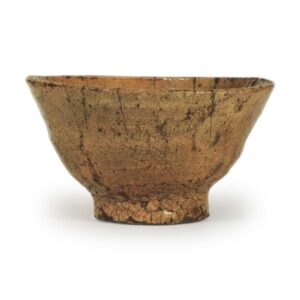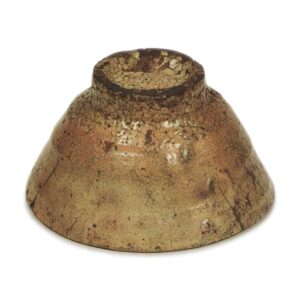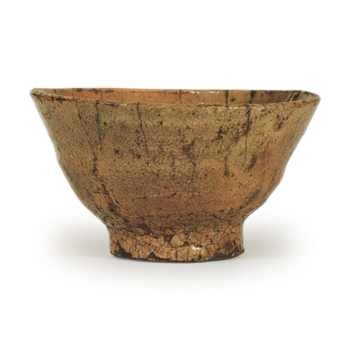

Daimyo-butsu
Fujita Art Museum
Height: 7.9 – 8.4 cm
Diameter: 14.3 – 14.9 cm
Base diameter: 6.5 cm
Height: 1.2 – 1.5 cm
The base is particularly large and sturdy, and has the appearance of an old tree spreading its roots across the earth. Compared to the well-known Tōtō-no-Ido, it has a very different appearance. The glaze is also dry and bluish, and the foot of the bowl, which is decorated with a plum blossom pattern, looks like a moss-covered rock. The signature of Furuta Oribe is also very impressive.
Although the height and diameter are similar to those of a large well, the foot ring makes it look smaller, so it is thought to be a small well. However, the style is different from that of the so-called small wells, and the impression of its imposing four sides is so great that even Fushimiya included it in his famous tea bowl collection, even though it is a large well.
The body has four levels of lathe marks, and the glaze is moist and slightly bluish. There is a single spot where the glaze has come off the kaaragi (plum blossom skin) pattern around the base, adding to the scene. There are five marks on the inside, and the scattered stains are also very tea-like.
The solid, stable foot of the bowl is the main attraction of this tea bowl, but the entire surface of the kaoragi covering it, and in particular the large kaoragi on the inside of the foot, is like a glacier that has cracked open, and is a perfect complement to the foot of the bowl. The peeling of the kaaragi from the tatami mats adds to the sense of foreboding. The highlight of this teacup is the foot ring, which, combined with the simple design, gives the impression of a bold and powerful presence.
It is said that the tea bowl was originally owned by Toyotomi Hideyoshi, and then given to Furuta Oribe, who inscribed the name of an old priest on the inside of the lid. It was later passed on to Isoda Sukezoemon, and then to his grandson Kaiho Gentarō. Incidentally, the Kaiho family was one of the wealthiest merchants in Edo, and was known for its possession of many famous tea utensils. Later, in the 9th year of Bunsei, it was presented to the Mito Tokugawa family by the Kaihō family at the request of the Mito Tokugawa family’s Nakanojo, Nariaki (Aikō), but it was sold to the Osaka Fujita family at the auction of the Mito Tokugawa family’s collection in the 7th year of Taishō, and since then it has been passed down in the Fujita family, and after the war it became part of the Fujita Art Museum’s collection when the museum was established. Recently, in addition to being exhibited at the museum, it was also exhibited at the Koetsukai exhibition in 1964.
Inner box, lid, inscription by Furuta Oribe “Rousou-chawan”
Outer box, lid, inscription “Ido-chawan mei Rousou-chawan Furuta Oribe-dono koshitsuke”
On the reverse of the lid: “Aiko Iai Saiaki Ki (signature)” by Tokugawa Nariaki (Rei-kou) of the Mito Tokugawa family
Saiaki Rei-kou (Kageyama) was a tea master and a connoisseur of ceramics, and he studied the art of pottery himself, making hand-made tea bowls in the style of Koetsu.
In the accompanying documents, the following is notable as a record of the history of the tea bowl, so we will mention it here.
Rousou Ido Tea Bowl
Owned by the shogun, given to Furuta Oribe, then owned by Isoda Sukezoemon, the old monk Mangetsu. The old monk’s tea bowl was passed on to his grandson Kaibo Gentarō. The Mangetsu tea bowl was passed down to someone named Kaibo, and then to the Lord Horita Sagami no Kami, and then to the Takeda Choshun’in.



